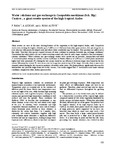Water relations and gas exchange in Coespeletia moritziana (Sch. Bip) Cuatrec., a giant rosette species of the high tropical Andes

Voir/
Date
2012-04-26Palabras Clave
net photosynthetic rate, osmotic adjustment, plant growth stages, stomatal conductance, tropical mountainsMetadatos
Afficher la notice complèteRésumé
Giant rosettes are ones of the most striking features of the vegetation in the high tropical Andes, with Coespeletia moritziana reaching the highest altitudes up to 4,600 m a.s.l. Different from other giant rosettes, this species grows on rock outcrops with poorly developed soils and where water availability may be limited. Two questions are addressed in this study: How does this species respond in terms of water relations to maintain favorable gas-exchange conditions? Considering that adult plants rely on a water-reserving central pith, how do early stages respond to this environment´s
extreme conditions? Water relations and gas-exchange studies were carried out on juveniles, intermediate and adult C. moritziana plants during wet and dry seasons in Páramo de Piedras Blancas at 4,200 m a.s.l. Adult plants maintained higher leaf water potentials (ΨL) during the wet season, however, no differences between stages were found for the dry season. Minimum dry season ΨL were never near the turgor loss point in any of the stages. Juveniles show a more strict stomatal control during the dry season to maintain a favorable water status. Net photosynthesis significantly decreased in
intermediate and juvenile stages from wet to dry seasons. Our results suggest that C. moritziana resists more extreme conditions compared to other Andean giant rosettes.
Colecciones
Información Adicional
| Correo Electrónico | frada@ula.ve aazocar@ula.ve |
| Editor | Photosynthetica 50: 429-436 |
| Colación | 429-436 |
| País | Venezuela |
| Institución | Universidad de Los Andes |





